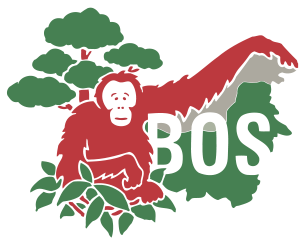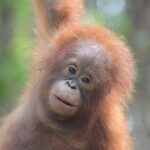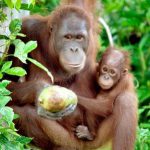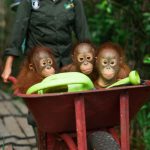FROM US FOR THE ORANGUTANS

In addition to Post-Release Monitoring (PRM), PT. Restorasi Habitat Orangutan Indonesia (PT. RHOI)* also runs a habitat management and restoration program (PPH). This program is one of the ecosystem restoration activities carried out by the RE-PPH Division.
The RE-PPH division manages domestic waste generated during camp operations, oversees the genetic resource conservation area and leads important reforestation efforts, ensuring the long-term health and sustainability of the ecosystem.
Since early May, the RE-PPH team has been working hard on the reforestation program, which required several key preparations. These included repairing the nursery building, sourcing nutrient-rich humus soil, and collecting seeds from mother trees. The nursery is where plant seedlings are cultivated until they are ready to be planted in new areas. The team used the extraction method to obtain these seedlings: they gathered seedlings growing near the mother tree and nurtured them in the nursery until they were strong enough to be replanted in different locations.

The team takes care of the seedlings they gathered near the mother tree. Once strong enough, they replant them in the Kehje Sewen Forest.
Ten tree species successfully transplanted
Currently, there are approximately ten species of food and nesting trees that have been successfully transplanted, including Artocarpus sp., Lithocarpus sp., Pternandra sp., Adinandra sp., Durio sp., and Nephelium sp. These species were carefully selected to enrich and expand the variety of food and nesting trees for orangutans in the Kehje Sewen Forest, supporting their long-term survival in the wild.
However, managing the nursery is quite challenging. Not all of the transplanted seedlings thrive. Some die, others are unhealthy, and some are attacked by insect pests. Whether due to errors in the transplanting technique or ineffective post-transplant care, challenges remain.
Working hard on improving the survival rate
Nevertheless, the team continues to evaluate and improve methods to increase the survival rate of the seedlings in the nursery. The planting medium is a critical factor in the success of the nursery process. The team members eventually sought soil with a higher humus content and mixed it with leftover wood shavings. After improving the planting medium, they replaced the dead plants with newly transplanted seedlings.
The survival rate improved
Hard work pays off! After optimizing the transplanting techniques, the plants are now growing much better. Every day before starting the main activities, the team begins the day by monitoring the development of the plants in the nursery. The photos show that maintaining the seedling is a key part of our routine. The RE-PPH members are busy watering the plants, weeding, and clearing unwanted plants from the nursery beds and surrounding areas. Now, the survival rate of the plants in the nursery is improving daily.
With continued care and maintenance, we are confident that these plants in the nursery will continue to thrive and soon be ready for planting in new areas of the Kehje Sewen Forest.
*PT. RHOI (Restorasi Habitat Orangutan Indonesia) was established by the BOS Foundation on April 21, 2009, with the sole purpose of providing a permanent place of safety for wild, semi-wild and rehabilitated orangutans where they can live in freedom, eventually creating new, viable wild populations to safeguard the survival of this species.
Text and Photos by: RE-PPH Team, PT. RHOI at Kehje Sewen Forest, East Kalimantan
Find out more about our conservation work here.





